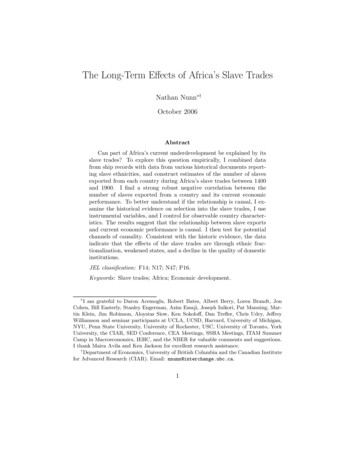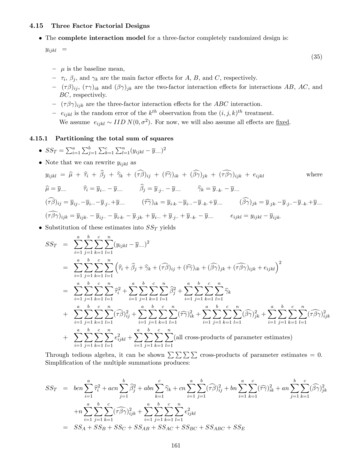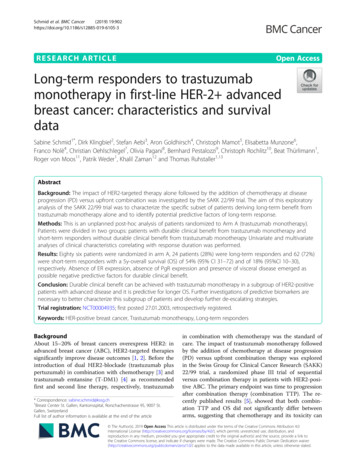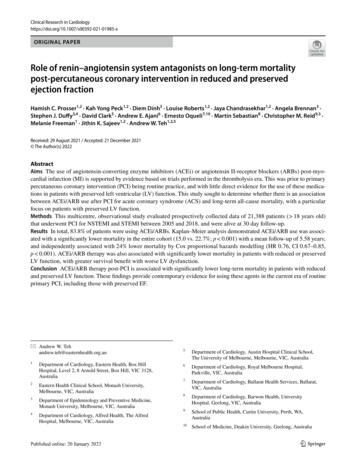
Transcription
The Long-Term Effects of Africa’s Slave TradesNathan Nunn †October 2006AbstractCan part of Africa’s current underdevelopment be explained by itsslave trades? To explore this question empirically, I combined datafrom ship records with data from various historical documents reporting slave ethnicities, and construct estimates of the number of slavesexported from each country during Africa’s slave trades between 1400and 1900. I find a strong robust negative correlation between thenumber of slaves exported from a country and its current economicperformance. To better understand if the relationship is causal, I examine the historical evidence on selection into the slave trades, I useinstrumental variables, and I control for observable country characteristics. The results suggest that the relationship between slave exportsand current economic performance is causal. I then test for potentialchannels of causality. Consistent with the historic evidence, the dataindicate that the effects of the slave trades are through ethnic fractionalization, weakened states, and a decline in the quality of domesticinstitutions.JEL classification: F14; N17; N47; P16.Keywords: Slave trades; Africa; Economic development. I am grateful to Daron Acemoglu, Robert Bates, Albert Berry, Loren Brandt, JonCohen, Bill Easterly, Stanley Engerman, Azim Essaji, Joseph Inikori, Pat Manning, Martin Klein, Jim Robinson, Aloysius Siow, Ken Sokoloff, Dan Trefler, Chris Udry, JeffreyWilliamson and seminar participants at UCLA, UCSD, Harvard, University of Michigan,NYU, Penn State University, University of Rochester, USC, University of Toronto, YorkUniversity, the CIAR, SED Conference, CEA Meetings, SSHA Meetings, ITAM SummerCamp in Macroeconomics, IEHC, and the NBER for valuable comments and suggestions.I thank Maira Avila and Ken Jackson for excellent research assistance.†Department of Economics, University of British Columbia and the Canadian Institutefor Advanced Research (CIAR). Email: nnunn@interchange.ubc.ca.1
1IntroductionAfrica’s economic performance in the second half of the twentieth centuryhas been poor.1 One, often informal, explanation for Africa’s underdevelopment is its history of extraction, characterized by two events: the slave tradesand colonialism. Bairoch (1993, p. 8) writes that “there is no doubt that alarge number of negative structural features of the process of economic underdevelopment have historical roots going back to European colonization.”Manning (1990, p. 124) echoes Bairoch, but focuses on the slave trades,writing: “Slavery was corruption: it involved theft, bribery, and exerciseof brute force as well as ruses. Slavery thus may be seen as one source ofprecolonial origins for modern corruption.”Recent empirical studies suggest that Africa’s history can explain partof its current underdevelopment. These studies focus on the link betweencountries’ colonial experience and current economic development (Bertocchiand Canova, 2002; Englebert, 2000a,b; Grier, 1999; Lange, 2004; Acemogluet al., 2001, 2002). However, the other important event in Africa’s history,its slave trades, has yet to be examined empirically. There are reasons toexpect that the slave trades may be at least as important as official colonialrule for Africa’s development. For a period of nearly 500 years, from 1400to 1900, the African continent simultaneously experienced four slave trades.By comparison, official colonial rule lasted from 1885 to about 1960, a totalof approximately 75 years.This paper provides the first empirical examination of the importance ofAfrica’s slave trades in shaping subsequent economic development. In doingthis, I construct measures of the number of slaves exported from each country in Africa, in each century between 1400 and 1900. The estimates areconstructed by combining data from ship records on the number of slavesshipped from each African port or region with data from a variety of historical documents that report the ethnic identities of slaves that were shippedfrom Africa. I find a robust negative relationship between the number ofslaves exported from each country and subsequent economic performance.The African countries that are the poorest today are the ones from whichthe most slaves were taken.This finding cannot be taken as conclusive evidence that the slave tradescaused differences in subsequent economic development. An alternative explanation that is just as plausible is that countries that were initially themost economically and socially underdeveloped selected into the slave trades,1See Artadi and Sala-i-Martin (2003) for a recent survey.2
and these countries continue to be the most underdeveloped today. In otherwords, the slave trades may be correlated with unobserved country characteristics, resulting in biased estimates of the effect of the slave trades oneconomic development.I pursue a number of strategies to better understand the reason behindthe relationship between slave exports and current economic performance.First, I review the evidence from African historians on the nature of selectioninto the slave trades. I also use historic data on pre-slave trade populationdensities to examine whether it was the less developed parts of Africa thatselected into the slave trades. Both sources of evidence show that it was actually the most developed areas of Africa that tended to select into the slavetrades. I discuss the reason behind this seemingly paradoxical relationshipin detail. Second, I use two sets of instruments to estimate the causal effectof the slave trades on subsequent economic development. The first instruments are the sailing distances from each country to the nearest location ofdemand for slave labor in each of the four slave trades. The second is initialpopulation density, controlling for current population density in the secondstage. Like the OLS coefficients, the IV coefficients are negative and significant, suggesting that increased extraction during the slave trades causedworse subsequent economic performance. The final strategy that I pursueis to control for a number of additional observable country characteristics.These results also indicate that the slave trades did have a negative effecton subsequent economic development.I then explore the precise channel of causality underlying the relationship between slave exports and subsequent economic development. Usinghistorical evidence as a guide, I examine whether the procurement of slavesthrough internal warfare, raiding, and kidnapping resulted in subsequentstate collapse, ethnic fractionalization, and a deterioration in the qualityof judicial institutions. I find support for the view that the slave tradesresulted in weak, politically fragmented states, ethnic fractionalization, andpoor judicial institutions.These findings complement the research of Engerman and Sokoloff (1997,2002) and Sokoloff and Engerman (2000), which shows that slavery in theNew World resulted in the evolution of institutions that were not conducive for economic growth.2 My results show that not only was the useof slaves detrimental for a society, but the production of slaves, which occurred through domestic warfare, raiding, and kidnapping, also had negative2Also see Lagerlöf (2005) who shows that within the U.S., the states that relied themost heavily on slavery in the past have the lowest income levels today.3
impacts on subsequent development.3The paper is structured as follows. In the following section, I provide anoverview of Africa’s slave trades, providing a detailed historical overview ofthe manner in which slaves were procured, and the resulting adverse effects.In Section 3, I describe the construction of the slave export figures. Section4 documents the correlations that exist in the data, and Section 5 turnsto the issue of causality. In Section 6, guided by the historical evidence, Itest for potential channels of causality. Section 7 reports the robustness andsensitivity checks, and Section 8 concludes.22.1The History of Africa’s Slave TradesGeneral OverviewBetween 1400 and 1900, the African continent experienced four simultaneousslave trades. The largest and most well-known is the trans-Atlantic slavetrade where, beginning in the 15th century, slaves were shipped from WestAfrica, West Central Africa and Eastern Africa to the European coloniesin the New World. The three other slave trades – the trans-Saharan, RedSea, and Indian Ocean slave trades – are much older and predate the transAtlantic slave trade. The beginning of the trans-Saharan and Red Sea slavetrades dates back to at least 600ad (Lovejoy, 2000). During the transSaharan slave trade, slaves were taken from south of the Saharan desertand to Northern Africa. In the Red Sea slave trade, slaves were taken frominland of the Red Sea and shipped to the Middle East and India. In theIndian Ocean slave trade, slaves were taken from Eastern Africa and shippedeither to the Middle East and India or to plantation islands in the IndianOcean.2.2Potentially Long-Term Consequences of Africa’s SlaveTradesA number of characteristics of Africa’s slave trades, particularly the transAtlantic slave trade, make them distinct from previous slave trades. First,3Also related is Acemoglu et al.’s (2005) research on the effects of the Atlantic threecorner trade in Europe. The authors find that in Europe, the Atlantic trade strengthened economic and political institutions conducive for economic growth. Similarly, Inikori(2002) argues that Britain’s involvement in the Atlantic trade was a key determinant ofits industrialization.4
the total volume of slaves traded was unprecedented. During the transAtlantic slave trade alone, approximately 12 million slaves were exportedfrom Africa. This figure does not include those who were killed during theraids or those who died on their journey to the coast.4 Africa’s slave tradeswere also unique because, unlike previous slave trades, individuals of thesame or similar ethnicities enslaved one another. This aspect of the slavetrades had particularly detrimental consequences.5 According to historicalevidence, the external demand for slaves impeded state development, causing weakened states, promoted political and social fragmentation, causingethnically fractionalized societies, and resulted in a deterioration of domesticinstitutions, particularly judicial institutions.62.2.1Ethnic FractionalizationThe detrimental impacts of the slave trades arise because the capture ofslaves occurred by Africans raiding other Africans. The most common manner in which slaves were taken was through villages or states raiding oneanother (Lovejoy, 1994; Northrup, 1978). Where groups of villages hadpreviously developed into larger scale village federations, relations betweenthe villages tended to turn hostile (Inikori, 2000). Villages began raidingeach other, destroying the established codes of conduct concerning warfarethat had promoted peace to this time. Kusimba (2004, p. 66) writes that“insecurity confined people within ethnic boundaries constructing spheresof interaction”. Hubbell (2001) documents this process for the region ofSouroudougou, which is located on the border of Burkina Faso and Mali.The networks and federations of villages that had formed, were destroyed asa result of the increased warfare, conflict, banditry, and suspicion generated4The Roman slave trade comes closest to matching the volume of the trans-Atlanticslave trade. Scheidel (1997) estimates that in the early Roman Empire, over a period offour centuries, between 10,000 and 15,000 slaves were shipped into the Empire annually.This is a total of 4 to 6 million slaves, which is less than half of the volume of the transAtlantic slave trade.5In early Rome, the primary source of slaves were prisoners captured by Roman soldiersduring wars of expansion. In later periods, slave populations were sustained primarilythrough slave breeding (Bradley, 1987). In Greece, clear regulations and institutionsprevented the enslavement of people of Greek origin, even when they were imprisoned, orcaptured in local civil wars (Garlan, 1987).6Because the effects of the slave trades were not homogenous across all regions of Africa,it is potentially dangerous to generalize the experience of the entire continent. I focus hereon the effects of the trans-Atlantic slave trade in particular. This is because, as I show inSection 7, the empirical results are driven by the trans-Atlantic slave trade. This is notsurprising given that this is the largest of the four slave trades.5
by the slave trade in the nineteenth century.Because the slave trades weakened ties between villages, they also discouraged the formation of larger communities and broader ethnic identities.Therefore, the slave trades may be an important factor explaining Africa’shigh level of ethnic fractionalization today. If this is the case, then this isa potential channel through which the slave trades may have long-term effects. The relationship between ethnic fractionalization and economic development was first documented by Easterly and Levine (1997). More recently,research by La Porta et al. (1999), Alesina et al. (2003), Aghion et al. (2004),and Easterly et al. (2006) looks more deeply into the importance of ethnicfractionalization, finding that it is also a primary determinant of social cohesion, domestic institutions, domestic polices, and the quality of government.Other research finds that ethnic fractionalization also reduces the provision of public goods (e.g., Alesina et al., 1999; Miguel and Gugerty, 2005;Banerjee and Somanathan, 2006), which may in turn affect development.2.2.2State Fragmentation and the Weakening of StatesThe conflict between communities, caused by the external demand for slaves,resulted in conflict within communities. Because of the general environmentof uncertainty and insecurity at the time, individuals required weapons,such as iron knives, spears, swords or firearms, to defend themselves. Theseweapons could be obtained from Europeans in exchange for slaves, whichwere often obtained through local kidnappings. This further perpetuated theslave trade and the insecurity that it caused, which in turn further increasedthe need to enslave others to protect oneself (Mahadi, 1992; Hawthorne,1999, pp. 108–109). Historians have named this vicious cycle the ‘gunslave cycle’ (e.g., Lovejoy, 2000) or the ‘iron-slave cycle’ (e.g., Hawthorne,2003). The result of this vicious cycle was that communities not only raidedother communities for slaves, but also members of a community raided andkidnapped others within the community. Well-documented examples comefrom the Balanta, of modern day Guinea-Bissau, who “became involved inslaving, often preying on other Balanta communities” and the Minyanka,of modern day Mali, who were forced by rival states “into participation inslave-raiding and bitter conflict between [other] Minyanka villages” (Klein,2001, pp. 56–57). The most extreme example is the Kabre of Northern Togo,who during the nineteenth century developed the custom of selling their ownkin into slavery (Piot, 1996).Europeans played a role in promoting political instability. Because thoseinvolved in the buying and selling of slaves benefited from a larger supply6
of slaves, when possible they intervened in the political process to promoteinternal conflict and instability (Barry, 1992; Inikori, 2003). Slave merchantsand raiders formed strategic alliances with key groups inside villages or statesin order to extract slaves. Typically, the alliances were with the younger menof the community who were frustrated by the control of power by the maleelders. The consequence of this was increased internal conflict and politicalinstability (Klein, 2003).In the end, the consequences of internal conflict and insecurity were increased political instability, and in many cases the collapse of pre-existingforms of government (Lovejoy, 2000, pp. 68–70). Historians have documented numerous examples of this. In 16th century Northern Senegambia,the Portuguese slave trade led to the eventual disintegration of the JoloffConfederation, which was replaced by the much smaller kingdoms of Waalo,Kajoor, Baol, Siin and Saalum. Further south, in Southern Senegambia, thesame pattern is observed. Prior to the slave trades, complex state systemswere in the process of evolving. However, this evolution stagnated soon afterthe arrival of the Portuguese in the 15th century (Barry, 1998, pp. 36–59).The most dramatic example of the weakening of domestic political institutions is the Kongo Kingdom of West Central Africa. As early as 1514, thekidnapping of local Kongo citizens for sale to the Portuguese had becomerampant, threatening social order and the King’s authority. In 1526, Affonso, King of Kongo, wrote to Portugal complaining that “there are manytraders in all corners of the country. They bring ruin to the country. Everyday people are enslaved and kidnapped, even nobles, even members of theking’s own family.” (Vansina, 1966, p. 52). This break-down of law andorder resulted in the weakening and eventual fall of the once powerful state(Inikori, 2003). For many of the other Bantu speaking ethnicities, stablestates also existed in earlier periods, but by the time the slave trades werebrought to an end few ancient states remained (Colson, 1969, pp. 36–37).77The research of Tilly (1990) and others argue that the modern system of nation statesin Europe was the result of constant conflict and competition between states. However, inAfrica the conflict caused by the slave trades did not result in the development of strongstates. Instead, the result was an increase in internal conflict, which retarded, ratherthan facilitated, state development. The reason for the difference is that during the slavetrades, individuals had an option of protecting themselves from the external insecurityby engaging in kidnappings and slave raiding within the community. Here, the individualcould gain at the expense of the community. In Europe, members of a community didnot have this option and as a result, their interests were aligned with the interests of thecommunity or state as a whole. It was in everyone’s best interest to maintain and promotestrong stable states. Lovejoy (2000, p. 70) addresses this difference between Africa andEurope, writing that “the record of warfare that fills the accounts of past [African] states7
Pre-existing governance structures were generally replaced by small bandsof slave raiders, controlled by an established ruler or warlord. These bandswere unable to develop into large, stable states. Colson (1969, p. 35) writesthat “both the bands and the new states they created retained an air ofimprovisation. Few band leaders were able to hand power to a legitimatesuccessor. Even where a band leader had become the ruler of a state, succession remained a problem. Leadership was a personal role, rather than anestablished office.”Two states in Western Africa did manage to emerge during the slavetrades: Oyo after 1650 and Asante after 1700. But they were never able tobecome large, especially relative to non-African states at the time (Lovejoy,2000, p. 69). The Oyo empire was short lived. It eventually weakened,disintegrated, and then collapsed – a process that began in the 1780s (Law,1977).This consequence of the slave trades may be important for current development. Recent empirical research shows that a country’s history of statedevelopment is an important determinant of current economic performance.Bockstette et al. (2002) find that ‘state antiquity’, measured using an indexof the depth of experience with state-level institutions, is positively correlated with real per capita GDP growth between 1960 and 1995. Gennaioliand Rainer (2005) find that within Africa, countries with ethnicities that hadcentralized pre-colonial state institutions today provide more public goods,such as education, health and infrastructure. Herbst (2000) argues thatAfrica’s poor economic performance is a result of “state failure”. He arguesthat because of low population densities, the process of state developmentthat took place in Europe did not occur in Africa. As others have pointedout (Robinson, 2002), Africa’s slave trades was an important factor affectingstate development directly and indirectly by depopulating the continent.8Political fragmentation also reinforced the effect that the slave tradeshad in promoting ethnic differences. Historically, having strong stable stateswas an important determinant of the subsequent ethnic and cultural homogeneity of the populations. On this point, Fearon (2003) correctly notesthat most of the countries that are ethnically homogenous today were veryfragmented 500 years ago. The subsequent development of strong statesfacilitated the transition to the cultural, ethnic, and linguistic homogeneityand rulers may not seem very different from the history of contemporary Europe or Asia,except that here the enslavement of people was the result, and no large states emergedthat could provide some semblance of unity and safety.”8For recent theoretical research on the detriment of weak states for economic development see Acemoglu (2005).8
that prevails today.92.2.3Deterioration of Legal InstitutionsThe slave trades also had a direct effect on legal institutions. An alternative way to obtain slaves was by falsely accusing others of witchcraft orother crimes. According to samples of slaves from Lovejoy (2000), Northrup(1978), and Koelle (1854), 4, 11, and 17% of the slaves entered slavery inthis manner. Klein (2001, p. 59) writes that “communities began enslavingtheir own. Judicial penalties that formerly had taken the form of beatings, payment of compensation or exile, for example, were now convertedto enslavement.” In many cases, leaders themselves supported or instigatedthis abuse of the judicial system (Mahadi, 1992; Klein, 2001). To protectthemselves and their community, leaders often chose to pay tribute to avoidbeing raided by other communities. The slaves needed for tribute were often obtained through the judicial system. Hawthorne (1999, 2003) providesdetailed studies of this process among the Cassanga of modern day GuineaBissau. The chief of the Cassanga used the ‘red water ordeal’ to procureslaves and their possessions. Those accused of a crime were forced to drinka poisonous red liquid. If they vomited, then they were judged to be guilty.If they did not vomit, they were deemed not guilty. However, for those thatdid not vomit this usually brought death by poisoning, and their possessionswere then seized, including all family members and relatives, who were thensold into slavery.The detrimental effects of the slave trades on the judicial system maybe important for current development if previous experience developing andmaintaining a well-functioning judicial system is helpful for implementingand sustaining legal institutions after independence. This may in turn becritical for development given the importance of domestic institutions foreconomic development (e.g., Acemoglu et al., 2001, 2002; Acemoglu andJohnson, 2004).The fact that the consequences of the slave trades may operate throughmultiple channels, particularly domestic institutions and ethnic fractionalization, is important. This is because recent research by Easterly (2001) andMiguel (2004) shows that strong domestic institutions and nation buildingpolicies can reduce the detrimental consequences of ethnic fractionalization.If the slave trades not only resulted in increased ethnic fractionalization,but also in weak states with poor domestic institutions and policies, then9See Gellner (1983) for a description of the relationship between centralized states andthe creation of a common national culture or identity.9
the negative consequences of ethnic fractionalization become much moreimportant.2.2.4Persistence of Predatory BehaviorThe final channel through which the slave trades may operate is through thepersistence of predatory behavior. Theoretical research shows that societiescan remain trapped in inefficient equilibria characterized by high levels ofpredation and low levels of production. Murphy et al. (1993) and Acemoglu(1995) show that under general conditions multiple equilibria can arise, somewith low levels of predatory behavior and some with high levels of predatorybehavior. If the slave trades caused parts of Africa to transition from a highincome equilibrium to a low income equilibrium, then the slave trades willhave persistent impacts. Nunn (2006b) puts forth an explanation of thisnature as one possible reason why Africa’s history may be an importantdeterminant of its current underdevelopment.102.2.5Positive EffectsAlthough the slave trades caused political and social fragmentation, andweakened domestic institutions, evidence suggests that they may have resulted in a strengthening and consolidation of networks of exchange andcredit (Lovejoy, 2000, p. 68). The efficient export of slaves not only requiredpolitical violence and instability, but also some strong commercial networks.As well, an additional consequence of the slave trades was the introductionof high yielding varieties of crops, such as maize, manioc, groundnuts, andlima beans (Vansina, 1990, pp. 211–216). These crops were imported byslave traders as a response to the sharp decline in food production thatresulted because of the insecurity generated by the slave trades.In the end, whether the total effect of the slave trades on economicdevelopment was positive or negative is an empirical question to which Inow turn.10As well, the persistence and importance of culture and social capital may be alternativereasons why the slave trades may matter. If the slave trades had a detrimental impact onthe culture or social capital of societies, then the effects of the slave trades may continueto be felt today.10
3Slave Export Data3.1Construction of EstimatesIn this section I provide an overview of the data sources and methodologyused to construct the slave export figures. Full details of the data construction are in Nunn (2006a).11To construct the slave export estimates, I rely on two types of data.The first are data that report the total number of slaves exported from eachport or region in Africa. I refer to these data as shipping data. For thetrans-Atlantic slave trade, the data are from the updated version of theTrans-Atlantic Slave Trade Database constructed by Eltis et al. (1999).12The database records 34,584 voyages from 1514 to 1866. The shipping dataare originally from various documents and records located around the world.In most European ports, merchants were required to register their ships,declare the volume and value of goods transported, pay duties, and obtainformal permission to leave the port. Therefore, for each ship and voyage,typically, there exists a number of different registers and documents. Aswell, shipping news and information published in newspapers and periodicalsprovide additional sources of information. In the database, 77% of the transAtlantic slave voyages after 1700 have shipping information from more thanone source. Voyages are documented in as many as sixteen different sourcesand the average number of sources of data for each voyage is six. Accordingto the authors’ estimates, the database contains 82% of all trans-Atlanticslaving voyages ever attempted (Eltis and Richardson, forthcoming).Data for the early period of the Atlantic slave trade not covered by theTrans-Atlantic Slave Trade Database are from Elbl (1997). For the IndianOcean, Red Sea and trans-Saharan slave trades data are from Austen (1979),Austen (1988), and Austen (1992). The data from these sources are based onestimates from all available documents, records and accounts by observersand government officials on the location and volume of slaves exports.With the shipping data one can calculate the number of slaves that wereshipped from each country. However, the data do not provide a reliable11The estimates only quantify Africa’s external slave trades, and therefore do not includeslaves that entered into domestic slavery. Because of a lack of data on the numbers andorigins of domestic slaves, I am unable to include these slaves in my estimates.12In Nunn (2004), I used the original version of the database. The new edition representsa significant improvement in the quality and completeness of the data. The updateddatabase includes the records of 8,005 new voyages and adds additional information for18,000 pre-existing voyages. In particular, the new database has 75% more informationon the slaves’ ports of embarkation (see Eltis and Richardson, forthcoming).11
estimate of how many slaves were enslaved or taken from each country.This is because slaves shipped from the ports of a coastal country may havecome from a country located further inland. To estimate the proportionof slaves shipped from the coast that came from inland countries, I use asecond source of data that reports the ethnicity identity of slaves that wereshipped outside of Africa. This information comes from a variety of sources:records of sale, plantation inventories, slave registers, slave runaway notices,court records, prison records, marriage records, death certificates, baptismalrecords, parish records, notarial records, and slave interviews.There were a number of ways of identifying the ethnicity or ‘nation’ ofslaves. A slave’s ethnicity could often be determined from ethnic markings,such as cuts, scars, the filing of teeth, and hairstyles (Karasch, 1987, pp.4–9). Oldendorp (1777, p. 169) writes that “the people of all Negro nationsare marked with certain cuts on the skin. As far as I have been able tolearn from the Negroes themselves, these serve to distinguish one nationfrom another.” Each ethnicity’s markings were well-known at the time, andwere formally documented in Oldendorp (1777).Because slaves were legally defined a
Atlantic slave trade, make them distinct from previous slave trades. First, 3Also related is Acemoglu et al.’s (2005) research on the effects of the Atlantic three-corner trade in Europe. The authors find that in Europe, the Atlantic trade strength-ened economic and political insti











